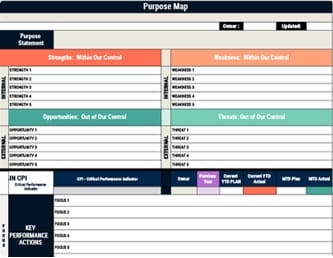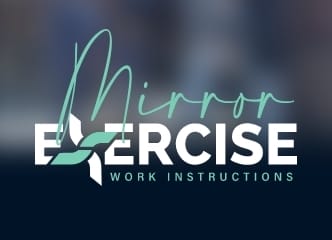Most execution failures aren’t strategic, they’re calendar failures—you haven’t built a 90-day rhythm that forces choices, action, and learning. You’ll define a few measurable objectives, link them to weekly commitments, and use tight feedback loops to expose bottlenecks before they compound. You’ll also shift from founder-doing to team-owned execution, align metrics that drive decisions, and meet investor expectations at each stage. Here’s how to set up the Planning, Massive Action, and Review system that makes this work.
Key Takeaways
- Translate vision into 3–5 quarterly priorities with measurable OKRs, clear owners, and decision rights.
- Run a 90-day sprint: plan, execute massively with weekly check-ins, and review with stakeholder input.
- Track decision-driving KPIs (CAC, payback, retention) and an Execution Pulse Score to spot bottlenecks early.
- Use visual management (1-3-10 second rule) for rapid status checks and issue escalation.
- Build feedback loops to adjust scope from customer signals while preserving cadence and accountability.
Understanding the Execution Gap and Why It Matters
Why do well-crafted strategies so often fall short in practice? You face an execution gap—the space between intent and results—where plans look sound on paper but stall in daily operations, handoffs, and metrics.
With over 67% of strategies failing due to execution issues, you can’t treat execution as an afterthought; you must translate vision into repeatable behaviors, measurable outputs, and tight feedback loops.
Execution isn’t optional—turn vision into repeatable behaviors, measurable outputs, and tight feedback loops.
Early-stage teams, especially around Series A or B, feel this most, as scaling exposes weak processes and unclear ownership. Define objectives that tie directly to customer success, align roles, and set cadences that surface risks early.
Consistent execution builds credibility, keeps teams aligned with the vision, and compounds gains over time, turning strategic direction into sustainable growth.
Leaders can learn from companies like Tesla, Airbnb, and PayPal, which aligned strategy and execution through clear objectives and tools like OKRs, rigorous cross-functional collaboration, and frequent reviews to maintain focus and adaptability.
Investor Expectations Across Stages: From Angels to Private Equity
Even as your product and team evolve, investor expectations shift in predictable ways, and you need to adjust how you prove execution at each stage.
With angels, show a crisp path from vision to prototype, early traction that signals product-market fit, and clear learning loops from user feedback, while outlining initial strategic initiatives that validate demand.
Seed and Series A investors expect repeatable customer acquisition, so quantify customer acquisition cost, payback period, and retention, and explain how you’ll scale channels without eroding unit economics.
To meet these expectations, implement aligned OKRs and regular progress tracking to connect strategic priorities with execution and demonstrate accountability over time.
Mapping Startup Growth Stages to Execution Focus
As your startup moves from early stage to growth and then to maturity, you should shift your execution focus to match the realities of each phase, because what proves progress at one stage can stall you at the next.
In the early stage, prioritize product-market fit and refine your business model, translating insights into small, testable commitments that close the execution gap causing founder frustrations.
In the growth stage, build a disciplined execution framework, establish clear ownership and communication cadences, and standardize processes so scaling doesn’t amplify chaos.
In maturity, emphasize operational efficiency, align teams to strategic objectives, and use metrics like an Execution Pulse Score to monitor consistency and health. Strengthening both vertical and horizontal alignment at this stage improves collaboration and productivity, which correlates with faster revenue growth and higher profitability.
Throughout, engage stakeholders, since investor expectations evolve and directly shape resourcing and priorities.
The 90-Day Sprint Framework: Planning, Action, and Review
Three deliberate phases—Planning, Massive Action, and Review—anchor a 90-day sprint that converts strategy into measurable results without overwhelming your team.
In the planning phase, you set three to five priorities, translate them into specific objectives, and define the actions, owners, and timelines that form a simple roadmap, which protects focus and prevents initiative overload.
Massive Action is where you execute, dedicating time, resources, and cross-functional support to ship milestones, remove blockers quickly, and track measurable progress against the roadmap.
Massive Action turns plans into shipped milestones, clearing blockers fast and tracking progress against a simple roadmap.
In the review phase, you analyze outcomes using key questions—what worked, what didn’t, and why—then capture lessons, adjust targets, and refine your next sprint.
This cycle builds a fail-forward mindset, maintains alignment with business priorities, and guarantees disciplined, repeatable execution. To strengthen this cycle, ensure stakeholder involvement from the earliest planning through review so insights, ownership, and operational realities stay tightly aligned with strategic choices.
Building Weekly Rhythms, Ownership, and Feedback Loops
You’ve set your 90-day priorities and run a focused sprint; now you need weekly rhythms, clear ownership, and tight feedback loops to keep execution on track between reviews.
Anchor a brief, same-time weekly meeting where each owner reports status, blockers, and next commitments, which keeps alignment tight and reduces drift from strategic priorities.
Assign a single accountable owner to every initiative and sub-task, clarify decision rights, and document handoffs, so there’s no ambiguity about who moves work forward.
Build feedback loops by capturing outcomes, noting what helped or hindered progress, and adjusting plans in real time rather than waiting for formal reviews.
End each week with a structured reflection, extract lessons, and update playbooks, creating a disciplined, fail-forward system that compounds operational efficiency.
To sustain momentum, empower middle managers with clear authority and resources to act as crucial linchpins, ensuring two-way communication and accountability between strategy and frontline execution.
Metrics That Matter: From Vanity to Decision-Driving Indicators
Although big numbers can look impressive, execution improves only when you track metrics that change decisions, not vanity signals. You should define metrics that matter by tying every Key Performance Indicator to a clear strategic objective, a decision owner, and a weekly review cadence, ensuring that data prompts action rather than celebration. Replace superficial counts, like app downloads, with actionable indicators that reflect learning and value creation, such as Customer Value Velocity, which connects product usage, outcomes, and revenue timing. Use an Execution Pulse Score to monitor the rhythm of reality in your operations, highlighting bottlenecks and revealing where to adjust plans, resources, or scope. Set explicit targets, instrument your systems for reliable capture, and trigger predefined responses when thresholds are crossed, fostering agility without heroic efforts. To ensure execution doesn’t stall at measurement, translate strategy into observable Key Performance Actions that are reviewed daily to drive KPIs and ultimately move CPIs.
Leadership Shifts: From Doing to Enabling Aligned Execution
When the company’s scope outgrows your personal capacity to “do,” the leadership shift is to enable aligned execution by turning ownership, context, and cadence into the primary tools of management.
You stop being the bottleneck and start designing how work moves, ensuring decisions happen close to the problem with clear accountability. Define owners across product, go-to-market, and customer success, then set crisp objectives and decision rights so execution isn’t tied to personalities.
Act as an alignment catalyst: set direction, establish consistent communication rituals, and remove ambiguity before it multiplies. To support this, adopt OKRs to translate strategic objectives into measurable key results and create a shared cadence for alignment and review.
Delegate outcomes, not tasks, and require brief, regular updates tied to measurable progress. Calibrate cadence—weekly priorities, monthly reviews, quarterly resets—so teams self-correct quickly.
These leadership shifts create a durable system where empowerment, accountability, and speed reinforce each other.
Turning Vision Into Repeatable Value With Execution DNA
Discipline turns vision into value by embedding execution DNA—the repeatable habits, structures, and feedback loops that convert strategy into outcomes—across every team. You operationalize this by translating strategy into a 90-Day Sprint with a small set of measurable priorities, clear owners, and weekly checkpoints, ensuring focus and transparency. Define what success looks like, assign deadlines, and align each initiative to a strategic goal so effort maps directly to results. Use tight communication rhythms—brief standups, concise progress reports, and monthly reviews—to surface risks early and adjust scope without losing momentum. Build feedback loops that connect customer signals and market shifts to next sprint plans, maintaining agility. As these practices become routine, execution DNA compounds, turning predictable delivery into sustainable growth and durable advantage. Adopt visual management practices like the 1-3-10 second rule so teams can instantly spot status, locate issues, and know next actions through clear visual cues.
Frequently Asked Questions
Can You Describe Your Strategy for the First 90 Days?
You set three measurable priorities, translate them into a 90-day roadmap, and define owners, milestones, and metrics.
You launch weekly check-ins to review progress, unblock work, and adjust plans, while maintaining a visible dashboard for transparency.
You establish feedback loops with brief retrospectives, capture lessons, and refine tactics.
You align dependencies across teams, sequence high-impact tasks first, and limit work-in-progress to prevent overload, ensuring disciplined execution and compounding momentum.
What Is a Strategic Execution Framework?
Like a roadmap turning fog into streets, a strategic execution framework is a structured system that converts your vision into clear, actionable steps.
You define SMART objectives, align resources, set priorities, and assign owners, then establish metrics that drive decisions instead of vanity metrics.
You schedule regular reviews to assess progress, learn, and adjust plans, ensuring daily operations match strategy, while fostering accountability, transparency, and continuous improvement across teams and timelines.
How to Turn a Vision Into a Strategy?
Turn your vision into strategy by translating it into clear, measurable objectives, then analyze internal strengths and weaknesses alongside external opportunities and threats to set priorities.
Define initiatives that bridge gaps, assign owners, budgets, and deadlines, and map dependencies.
Build an action plan with milestones and risks, then select KPIs to track outcomes and leading indicators.
Engage stakeholders early, communicate expectations, and establish review cadences to adjust quickly and sustain alignment.
How Long Should It Take to Develop a Strategic Plan?
Let’s not dance around it: you should plan for three to six months, yet you can compress it into a focused 90-day sprint when urgency and clarity matter.
You’ll define a few high-impact priorities, assign owners, set measurable outcomes, and run weekly checks, which keeps momentum high and drift low.
Use month one for discovery and alignment, month two for design and resourcing, and month three for detailed roadmaps, risks, and execution cadence.
Conclusion
In ninety days, you turn vision into practice: set priorities, define measurable outcomes, and run disciplined sprints that echo “measure twice, cut once.” You build weekly rhythms, assign ownership, and use feedback loops to correct course before drift becomes fate. You track decision-driving metrics, not vanity signals, and shift from doing to enabling aligned execution. Like Odysseus steering past sirens, you commit to the plan, review the voyage, and codify what works so progress becomes repeatable value.



